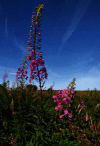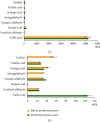Eurotium Cristatum Postfermentation of Fireweed and Apple Tree Leaf Herbal Teas
- PMID: 34631875
- PMCID: PMC8500772
- DOI: 10.1155/2021/6691428
Eurotium Cristatum Postfermentation of Fireweed and Apple Tree Leaf Herbal Teas
Abstract
Fungi Eurotium spp. are the main biological agents that ferment the leaves of the Camellia sinensis tea bush to form a popular food product, postfermented tea. The fungus E. cristatum, stored in the collection of the Gause Institute of New Antibiotics under the number INA 01267, was isolated and identified from a briquette of Fujian Chinese tea. The species identification was carried out based on morphocultural characteristics and DNA sequencing. This study is aimed at determining the feasibility of making postfermented herbal teas using E. cristatum and to evaluate their quality. Autofermented herbal teas from Chamaenerion angustifolium (fireweed) and Malus domestica (apple tree) served as the starting material for this study. The change in the concentration of phenolic compounds, organic acids, sugars, and free amino acids was observed for herbal teas subjected to postfermentation with E. cristatum INA 01267. It was found that the E. cristatum INA 01267 strain does not have antimicrobial activity and does not form mycotoxins, which is an indicator of food safety.
Copyright © 2021 Tatiana A. Efimenko et al.
Conflict of interest statement
The authors declare that there is no conflict of interest regarding the publication of this paper.
Figures






Similar articles
-
Insight into effects of isolated Eurotium cristatum from Pingwu Fuzhuan brick tea on the fermentation process and quality characteristics of Fuzhuan brick tea.J Sci Food Agric. 2020 Jul;100(9):3598-3607. doi: 10.1002/jsfa.10353. Epub 2020 Apr 20. J Sci Food Agric. 2020. PMID: 32100298
-
Secondary Metabolites Produced by the Dominant Fungus Eurotium cristatum in Liupao Tea and Their Hypolipidemic Activities by Regulating Liver Lipid Metabolism and Remodeling Gut Microbiota.J Agric Food Chem. 2024 Dec 18;72(50):27978-27990. doi: 10.1021/acs.jafc.4c09010. Epub 2024 Dec 3. J Agric Food Chem. 2024. PMID: 39626216
-
Influence of Eurotium cristatum and Aspergillus niger individual and collaborative inoculation on volatile profile in liquid-state fermentation of instant dark teas.Food Chem. 2021 Jul 15;350:129234. doi: 10.1016/j.foodchem.2021.129234. Epub 2021 Feb 6. Food Chem. 2021. PMID: 33588283
-
A billion cups: The diversity, traditional uses, safety issues and potential of Chinese herbal teas.J Ethnopharmacol. 2018 Aug 10;222:217-228. doi: 10.1016/j.jep.2018.04.026. Epub 2018 May 3. J Ethnopharmacol. 2018. PMID: 29730132 Review.
-
Mycotoxins along the tea supply chain: A dark side of an ancient and high valued aromatic beverage.Crit Rev Food Sci Nutr. 2023;63(27):8672-8697. doi: 10.1080/10408398.2022.2061908. Epub 2022 Apr 22. Crit Rev Food Sci Nutr. 2023. PMID: 35452322 Review.
Cited by
-
Epilobium angustifolium L. as a Potential Herbal Component of Topical Products for Skin Care and Treatment-A Review.Molecules. 2022 May 31;27(11):3536. doi: 10.3390/molecules27113536. Molecules. 2022. PMID: 35684473 Free PMC article. Review.
-
Morphological variation and expressed sequence tags-simple sequence repeats-based genetic diversity of Aspergillus cristatus in Chinese dark tea.Front Microbiol. 2024 Jun 3;15:1390030. doi: 10.3389/fmicb.2024.1390030. eCollection 2024. Front Microbiol. 2024. PMID: 38887709 Free PMC article.
-
Material Composition Characteristics of Aspergillus cristatus under High Salt Stress through LC-MS Metabolomics.Molecules. 2024 May 26;29(11):2513. doi: 10.3390/molecules29112513. Molecules. 2024. PMID: 38893389 Free PMC article.
-
The complete chloroplast genome of Erodium stephanianum (Geraniaceae).Mitochondrial DNA B Resour. 2024 Nov 12;9(11):1501-1505. doi: 10.1080/23802359.2024.2419962. eCollection 2024. Mitochondrial DNA B Resour. 2024. PMID: 39539984 Free PMC article.
References
-
- Hui Y. H., Meunier-Goddik L., Josephsen J., Nip W.-K., Stanfield P. S. Handbook of Food and Beverage Fermentation Technology . New York, USA: Marcel Dekker, Inc.; 2004. - DOI
-
- Yashin A. Y., Nemzer B. V., Combet E., Yashin Y. I. Determination of the chemical composition of tea by chromatographic methods: a review. Journal of Food Research . 2015;4(3):56–87. doi: 10.5539/jfr.v4n3p56. - DOI
-
- Cardoso R. R., Neto R. O., dos Santos D'Almeida C. T., et al. Kombuchas from green and black teas have different phenolic profile, which impacts their antioxidant capacities, antibacterial and antiproliferative activities. Food Research International . 2020;128, article 108782 doi: 10.1016/j.foodres.2019.108782. - DOI - PubMed
-
- Jayabalan R., Malbaša R. V., Lončar E. S., Vitas J. S., Sathishkumar M. A review on Kombucha tea-microbiology, composition, fermentation, beneficial effects, toxicity, and tea fungus. Comprehensive Reviews in Food Science and Food Safety . 2014;13(4):538–550. doi: 10.1111/1541-4337.12073. - DOI - PubMed
LinkOut - more resources
Full Text Sources
Molecular Biology Databases
Miscellaneous

